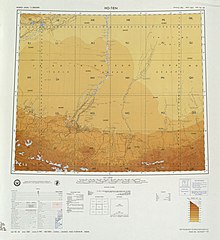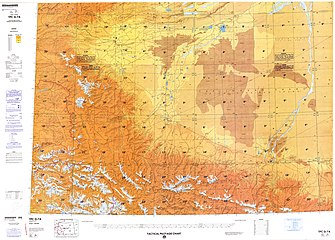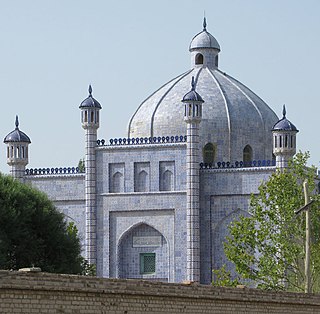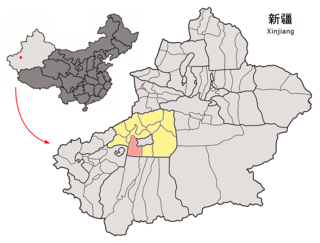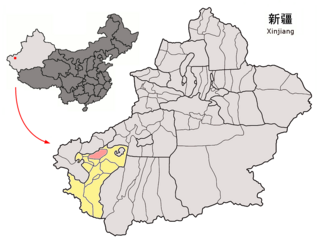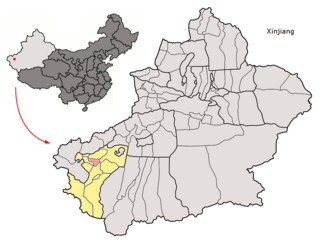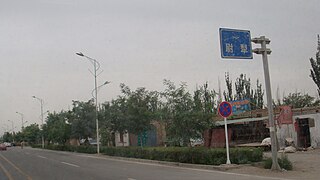Qira County Chira, Cele, Ts'e-le | |
|---|---|
 Location of the county in Hotan Prefecture (yellow) and Xinjiang | |
| Coordinates: 37°00′N80°48′E / 37.000°N 80.800°E | |
| Country | China |
| Autonomous region | Xinjiang |
| Prefecture | Hotan |
| County seat | Qira Town |
| Township-level divisions | 2 towns, 6 townships |
| Area | |
• Total | 31,688.01 km2 (12,234.81 sq mi) |
| Elevation | 1,500−7,282 m (4,900−23,981 ft) |
| Population (2020) [4] | |
• Total | 157,792 |
| • Density | 5.0/km2 (13/sq mi) |
| Ethnic groups | |
| • Major ethnic groups | Uyghur [1] [5] |
| Time zone | UTC+8 (China Standard [a] ) |
| Postal code | 848300 |
| Website | xjcl |
"When I woke up one morning, I found I couldn't open the door because of the weight of sand that had accumulated overnight. My crops were buried too, so I had no choice but to move" -Memet Simay, area resident [8]
In 1983, the Qira research station of the Chinese Academy of Sciences was founded to combat drift sand. [9] A transitional zone was established with help from the scientists at the station, and the sands were pushed back over 5 kilometres (3.1 mi). [14] [ better source needed ]
In 2005, a small 1,500 year-old Buddhist temple was discovered 7 km (4.3 mi) from Damiku (Damagou). [15]
On October 20, 2014, Damiku (Damagou) was changed from a township to a town. [2]
On January 7, 2016, areas near Nur, Bostan and Ulughsay townships in Qira County were made part of the newly created Kunyu. [16] [17]
On February 28, 2017, it was announced by the county government that those who reported others for stitching the 'star and crescent moon' insignia on their clothing or personal items or having the words 'East Turkestan' on their mobile phone case, purse or other jewelry, would be eligible for cash payments. [18]
In March 2017, Salamet Memetimin, the Communist Party secretary for Chaka township's Bekchan village and ethnic Uyghur, was relieved of her duties for taking her nikah marriage vows at her home. According to the Hotan Daily, 97 officials were charged with disciplinary violations at this time. [19]
In 2018, local government authorities in the county expected to have almost 12,000 detainees in vocational camps and detention centres and some projects related to the centres outstripped budgetary limits. [20]
According to the Chinese Government, by the end of 2018, construction of Jinnan New Village ( 津南 新村 ) in Qira Town (Cele) was completed. [21] To increase aid delivery to Xinjiang, places in Xinjiang are paired with other areas of China which can provide aid. Tianjin and Hotan are paired in this program. Through assistance from the Tianjin government, a standard football field and training center was constructed at the No. 1 Primary School in the county. [22]
Geography
The northern part of Qira County is made up of sand dunes [10] and ends in a straight line drawn in the Taklamakan Desert that forms part of the boundary between Hotan Prefecture and Aksu Prefecture. The area is between 1,500 m (4,900 ft) and 1,800 m (5,900 ft) above sea level. [1]
Oasis areas occupy 2.9% of the total area of the county. [1] The oasis areas along China National Highway 315 include the Qira County county seat area, Gulahma and Damiku. Qaka, Ulughsay, Nur, Bostan and Kunyu's small exclaves in Qira County are located close to the Kunlun Mountains.
The southern part of Qira County is mountainous with an average elevation of 3,200 m (10,500 ft) above sea level. [1] The upper reaches of the White Jade River (Yurung Kash), which provide water for Hotan (Khotan), are found in the Kunlun Mountains [1] of southern Qira County. [23] Mountain passes in the area include Mandar Kol Dawan, Shalgon Dawan, Kuchkash Bulak Dawan, and Art Dawan. [23] One of the prominent mountains in the county is Muztag [3] [24] (K5, [25] Wu-lu-ko Ho Shan, [10] Mo-shih Shan, [10] Mu-shih Shan, [26] Muztagh Jilga; [23] 慕士山, [27] 木斯山 [28] ) which is 7,282 m (23,891 ft) above sea level. [3] The meltwater from this mountain creates the Qira River (Cele River, Ts'e-lo Ho; [10] 策勒河 [29] ) which flows through Qaka into the Qira county seat. [10]
In the mid-20th century, camping grounds in the sparsely populated southern mountainous area of the county included Chotma, Yangi kan, Zaiuk, Yaskako Tagh, Mandar Chap, and Chumik. [23]
Climate
| Qira County | |||||||||||
|---|---|---|---|---|---|---|---|---|---|---|---|
| Uyghur name | |||||||||||
| Uyghur | چىرا ناھىيىسى | ||||||||||
| |||||||||||
| Climate data for Qira, elevation 1,337 m (4,386 ft), (1991–2020 normals, extremes 1981–2010) | |||||||||||||
|---|---|---|---|---|---|---|---|---|---|---|---|---|---|
| Month | Jan | Feb | Mar | Apr | May | Jun | Jul | Aug | Sep | Oct | Nov | Dec | Year |
| Record high °C (°F) | 20.0 (68.0) | 23.7 (74.7) | 32.3 (90.1) | 36.9 (98.4) | 38.0 (100.4) | 40.5 (104.9) | 42.0 (107.6) | 40.9 (105.6) | 36.8 (98.2) | 32.1 (89.8) | 25.1 (77.2) | 19.6 (67.3) | 42.0 (107.6) |
| Mean daily maximum °C (°F) | 1.8 (35.2) | 8.0 (46.4) | 17.4 (63.3) | 25.0 (77.0) | 29.1 (84.4) | 32.1 (89.8) | 33.7 (92.7) | 32.5 (90.5) | 28.5 (83.3) | 21.8 (71.2) | 12.6 (54.7) | 3.9 (39.0) | 20.5 (69.0) |
| Daily mean °C (°F) | −4.4 (24.1) | 1.5 (34.7) | 10.4 (50.7) | 17.4 (63.3) | 21.5 (70.7) | 24.7 (76.5) | 26.1 (79.0) | 24.9 (76.8) | 20.4 (68.7) | 12.6 (54.7) | 4.6 (40.3) | −2.5 (27.5) | 13.1 (55.6) |
| Mean daily minimum °C (°F) | −9.5 (14.9) | −4.4 (24.1) | 3.6 (38.5) | 10.2 (50.4) | 14.5 (58.1) | 18.1 (64.6) | 19.8 (67.6) | 18.7 (65.7) | 13.5 (56.3) | 5.1 (41.2) | −1.6 (29.1) | −7.4 (18.7) | 6.7 (44.1) |
| Record low °C (°F) | −21.8 (−7.2) | −20.7 (−5.3) | −9.3 (15.3) | −0.7 (30.7) | 2.6 (36.7) | 8.0 (46.4) | 11.5 (52.7) | 7.4 (45.3) | 1.9 (35.4) | −4.7 (23.5) | −13.7 (7.3) | −20.5 (−4.9) | −21.8 (−7.2) |
| Average precipitation mm (inches) | 1.3 (0.05) | 1.5 (0.06) | 2.3 (0.09) | 4.8 (0.19) | 8.4 (0.33) | 10.5 (0.41) | 7.7 (0.30) | 3.7 (0.15) | 6.9 (0.27) | 0.5 (0.02) | 0.5 (0.02) | 0.7 (0.03) | 48.8 (1.92) |
| Average precipitation days (≥ 0.1 mm) | 1.9 | 1.3 | 0.6 | 1.3 | 1.9 | 3.6 | 2.9 | 1.8 | 1.0 | 0.3 | 0.3 | 1.3 | 18.2 |
| Average snowy days | 4.5 | 2.2 | 0.5 | 0 | 0 | 0 | 0 | 0 | 0 | 0 | 0.5 | 3.0 | 10.7 |
| Average relative humidity (%) | 52 | 41 | 28 | 27 | 32 | 38 | 42 | 44 | 44 | 42 | 43 | 52 | 40 |
| Mean monthly sunshine hours | 180.4 | 180.9 | 202.3 | 223.7 | 260.5 | 257.4 | 246.6 | 233.9 | 237.8 | 258.1 | 216.7 | 185.0 | 2,683.3 |
| Percent possible sunshine | 58 | 58 | 54 | 56 | 59 | 59 | 56 | 57 | 65 | 76 | 72 | 62 | 61 |
| Source: China Meteorological Administration [30] [31] | |||||||||||||







